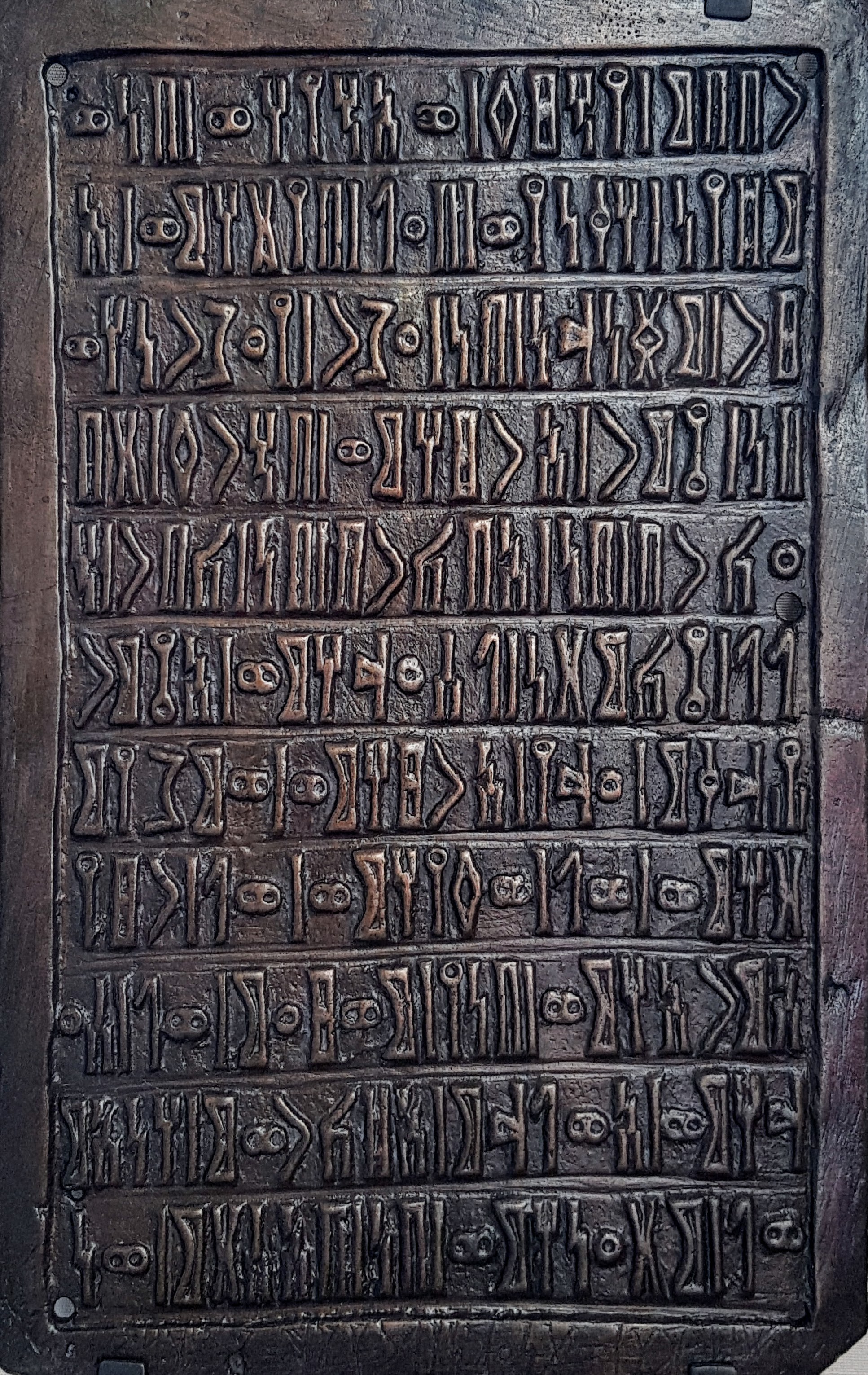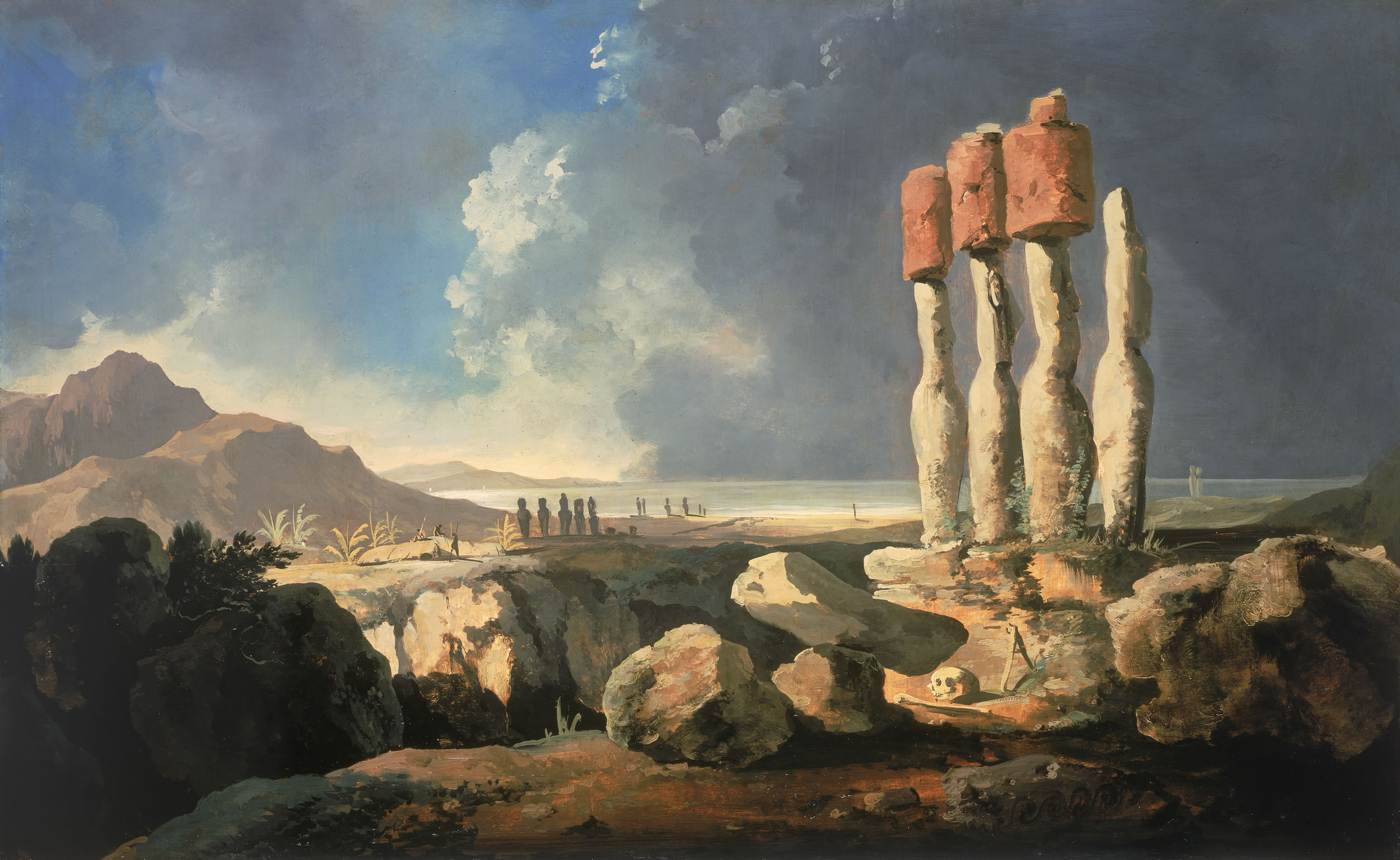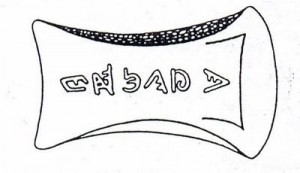|
Boustrophedon
Boustrophedon () is a style of writing in which alternate lines of writing are reversed, with letters also written in reverse, mirror-style. This is in contrast to modern European languages, where lines always begin on the same side, usually the left. The original term comes from , ', a composite of , ', "ox"; , ', "turn"; and the adverbial suffix -, -', "like, in the manner of" – that is, "like the ox turns hile plowing. It is mostly seen in ancient manuscripts and other inscriptions. It was a common way of writing on stone in ancient Greece, becoming less and less popular throughout the Hellenistic period. Many ancient scripts, such as Etruscan, Safaitic, and Sabaean, were frequently or even typically written boustrophedon. Reverse boustrophedon The wooden boards and other incised artefacts of Rapa Nui also bear a boustrophedonic script called Rongorongo, which remains undeciphered. In Rongorongo, the text in alternate lines was rotated 180 degrees rather than mirr ... [...More Info...] [...Related Items...] OR: [Wikipedia] [Google] [Baidu] [Amazon] |
Rongorongo
Rongorongo ( or ; Rapa Nui: ) is a system of glyphs discovered in the 19th century on Easter Island that has the appearance of writing or proto-writing. Numerous attempts at decipherment have been made, but none have been successful. Although some calendrical and what might prove to be genealogical information has been identified, none of the glyphs can actually be read. If rongorongo does prove to be writing and to be an independent invention, it would be one of very few inventions of writing in human history. Two dozen wooden objects bearing rongorongo inscriptions, some heavily weathered, burned, or otherwise damaged, were collected in the late 19th century and are now scattered in museums and private collections. None remain on Easter Island. The objects are mostly tablets shaped from irregular pieces of wood, sometimes driftwood, but include a chieftain's staff, a '' tangata manu'' statuette, and two '' reimiro'' ornaments. There are also a few petroglyphs which may incl ... [...More Info...] [...Related Items...] OR: [Wikipedia] [Google] [Baidu] [Amazon] |
Avoiuli
Avoiuli (from Raga 'talk about' and 'draw' or 'paint') is a writing system used by the Turaga indigenous movement on Pentecost Island in Vanuatu. It was devised by Chief Viraleo Boborenvanua over a 14-year period, based on designs found in traditional sand drawings, and intended as a native alternative to the Latin alphabet. It is used mainly for writing in the area's native Raga language, although it can also be used for other languages including Apma, Bislama and English. Features The Avoiuli alphabet comprises characters equivalent to the letters ''A''–''Z'', decimal numerals and other symbols, including a range of currency symbols representing the livatu and specific items of traditional value such as pigs and dyed mats. Like the Western orthography used to write Raga, it represents the velar nasal ''ng'' and prenasalised consonant ''ngg'' using modified forms of the letters ''n'' and ''g'' respectively, but represents the labiovelar consonants ''bw'', ''mw'' an ... [...More Info...] [...Related Items...] OR: [Wikipedia] [Google] [Baidu] [Amazon] |
Sabaean Language
Sabaic, sometimes referred to as Sabaean, was a Sayhadic language that was spoken between c. 1000 BC and the 6th century AD by the Sabaeans. It was used as a written language by some other peoples of the ancient civilization of South Arabia, including the Ḥimyarites, Ḥashidites, Ṣirwāḥites, Humlanites, Ghaymānites, and Radmānites. Sabaic belongs to the South Arabian Semitic branch of the Afroasiatic language family. Sabaic is distinguished from the other members of the Sayhadic group by its use of ''h'' to mark the third person and as a causative prefix; all of the other languages use ''s1'' in those cases. Therefore, Sabaic is called an ''h''-language and the others ''s''-languages. Numerous other Sabaic inscriptions have also been found dating back to the Sabean colonization of Africa. Sabaic is very similar to Arabic and the languages may have been mutually intelligible. Script Sabaic was written in the South Arabian alphabet, and like Hebrew and Arabic mar ... [...More Info...] [...Related Items...] OR: [Wikipedia] [Google] [Baidu] [Amazon] |
Hieroglyphic Luwian
Luwian (), sometimes known as Luvian or Luish, is an ancient language, or group of languages, within the Anatolian languages, Anatolian branch of the Indo-European languages, Indo-European language family. The ethnonym Luwian comes from ''Luwiya'' (also spelled ''Luwia'' or ''Luvia'') – the name of the region in which the Luwians lived. Luwiya is attested, for example, in the Hittite laws. The two varieties of Luwian are known after the scripts in which they were written: #Cuneiform Luwian, Cuneiform Luwian (''CLuwian'') and Hieroglyphic Luwian (''HLuwian''). There is no consensus as to whether these were a single language or two closely related languages. Classification Several other Anatolian languages – particularly Carian language, Carian, Lycian language, Lycian, and Milyan (also known as Lycian B or Lycian II) – are now usually identified as related to Luwian – and as mutually connected more closely than other constituents of the Anatolian branch.Anna Bauer, 2014, ... [...More Info...] [...Related Items...] OR: [Wikipedia] [Google] [Baidu] [Amazon] |
Luwian Language
Luwian (), sometimes known as Luvian or Luish, is an ancient language, or group of languages, within the Anatolian branch of the Indo-European language family. The ethnonym Luwian comes from ''Luwiya'' (also spelled ''Luwia'' or ''Luvia'') – the name of the region in which the Luwians lived. Luwiya is attested, for example, in the Hittite laws. The two varieties of Luwian are known after the scripts in which they were written: Cuneiform Luwian (''CLuwian'') and Hieroglyphic Luwian (''HLuwian''). There is no consensus as to whether these were a single language or two closely related languages. Classification Several other Anatolian languages – particularly Carian, Lycian, and Milyan (also known as Lycian B or Lycian II) – are now usually identified as related to Luwian – and as mutually connected more closely than other constituents of the Anatolian branch.Anna Bauer, 2014, ''Morphosyntax of the Noun Phrase in Hieroglyphic Luwian'', Leiden, Brill NV, pp. 9–10. Th ... [...More Info...] [...Related Items...] OR: [Wikipedia] [Google] [Baidu] [Amazon] |
Rapa Nui
Easter Island (, ; , ) is an island and special territory of Chile in the southeastern Pacific Ocean, at the southeasternmost point of the Polynesian Triangle in Oceania. The island is renowned for its nearly 1,000 extant monumental statues, called ''moai'', which were created by the early Rapa Nui people. In 1995, UNESCO named Easter Island a World Heritage Site, with much of the island protected within Rapa Nui National Park. Experts differ on when the island's Polynesian inhabitants first reached the island. While many in the research community cited evidence that they arrived around the year 800, a 2007 study provided compelling evidence suggesting their arrival was closer to 1200. The inhabitants created a thriving and industrious culture, as evidenced by the island's numerous enormous stone ''moai'' and other artifacts. Land clearing for cultivation and the introduction of the Polynesian rat led to gradual deforestation. By the time of European arrival in 1722, the i ... [...More Info...] [...Related Items...] OR: [Wikipedia] [Google] [Baidu] [Amazon] |
Forum Inscription
The Lapis Niger (Latin, "Black Stone") is an ancient shrine in the Roman Forum. Together with the associated Vulcanal (a sanctuary to Vulcan) it constitutes the only surviving remnants of the old Comitium, an early assembly area that preceded the Forum and is thought to derive from an archaic cult site of the 7th or 8th century BC. The black marble paving (1st century BC) and modern concrete enclosure (early 20th century) of the Lapis Niger overlie an ancient altar and a stone block with one of the earliest known Old Latin inscriptions (c. 570–550 BC). The superstructure monument and shrine may have been built by Julius Caesar during his reorganization of the Forum and Comitium space. Alternatively, this may have been done a generation earlier by Sulla during one of his construction projects around the Curia Hostilia. The site was rediscovered and excavated from 1899 to 1905 by Italian archaeologist Giacomo Boni. Mentioned in many ancient descriptions of the Forum dating ba ... [...More Info...] [...Related Items...] OR: [Wikipedia] [Google] [Baidu] [Amazon] |
Old Hungarian Script
The Old Hungarian script or Hungarian runes (, 'székely-magyar runiform', or ) is an alphabetic writing system used for writing the Hungarian language. Modern Hungarian is written using the Latin-based Hungarian alphabet. The term "old" refers to the historical priority of the script compared with the Latin-based one. The Old Hungarian script is a child system of the Old Turkic alphabet. The Hungarian people, Hungarians Hungarian conquest of the Carpathian Basin, settled the Carpathian Basin in 895. After the establishment of the Kingdom of Hungary (1000–1526), Christian Hungarian kingdom, the old writing system was partly forced out of use during the rule of Stephen I of Hungary, King Stephen, and the Latin alphabet was adopted. However, among some professions (e.g. shepherds who used a "rovás-stick" to officially track the number of animals) and in Transylvania, the script has remained in use by the Székelys, Székely Magyars, giving its Hungarian name . The writing could ... [...More Info...] [...Related Items...] OR: [Wikipedia] [Google] [Baidu] [Amazon] |
Etruscan Language
Etruscan ( ) was the language of the Etruscan civilization in the ancient region of Etruria, in Etruria Padana and Etruria Campana in what is now Italy. Etruscan influenced Latin but was eventually superseded by it. Around 13,000 Etruscan epigraphy, inscriptions have been found so far, only a small minority of which are of significant length; some bilingual inscriptions with texts also in Latin, Ancient Greek, Greek, or Phoenician language, Phoenician; and a few dozen purported loanwords. Attested from 700 BC to AD 50, the relation of Etruscan to other languages has been a source of long-running speculation and study. Nowadays, it is generally agreed to be in the Tyrsenian language family, but before it gained currency as one of the Tyrsenian languages, it was commonly treated as an Language isolate, isolate, although there were also a number of other less well-known hypotheses. The consensus among linguists and Etruscologists is that Etruscan was a Pre-Indo-European languages, Pre ... [...More Info...] [...Related Items...] OR: [Wikipedia] [Google] [Baidu] [Amazon] |
Safaitic
Safaitic ( ''Al-Ṣafāʾiyyah'') is a variety of the South Semitic scripts used by the Arabs in southern Syria and northern Jordan in the Harrat al-Sham, Ḥarrah region, to carve rock inscriptions in various dialects of Old Arabic and Ancient North Arabian. The Safaitic script is a member of the Ancient North Arabian (ANA) sub-grouping of the South Semitic script family, the genetic unity of which has yet to be demonstrated. The first attempt at a comprehensive Safaitic dictionary was published in 2019 by Ahmad Al-Jallad and Karolina Jaworska. Geographical distribution Safaitic inscriptions are named after the area where they were first discovered in 1857: Al-Safa (Syria), As-Safa, a region of basalt desert to the southeast of Damascus, Syria. Since then they have been found over a wide area including south Syria, eastern Jordan and northwestern Saudi Arabia. Isolated examples occur further afield in places such as Palmyra in Syria, in Lebanon, in Wadi Hauran in western Ir ... [...More Info...] [...Related Items...] OR: [Wikipedia] [Google] [Baidu] [Amazon] |








